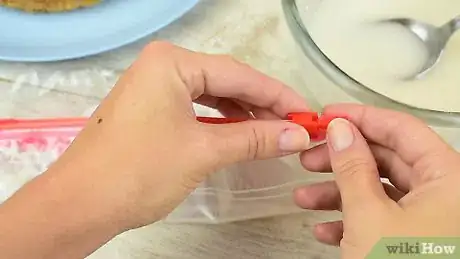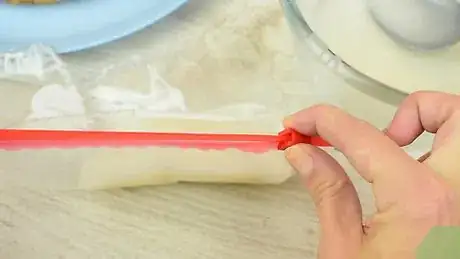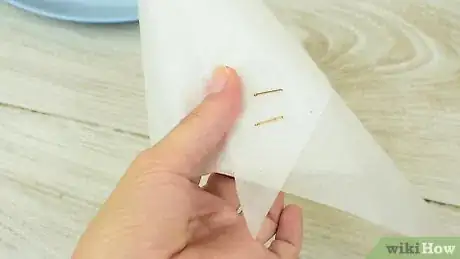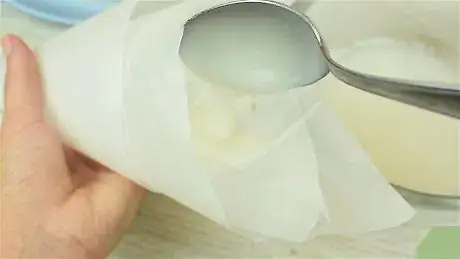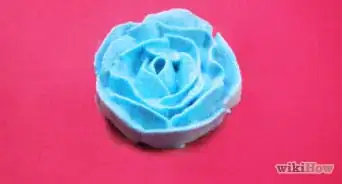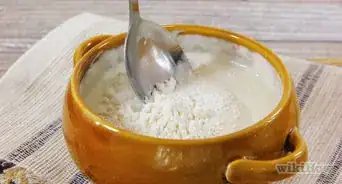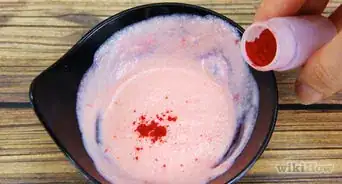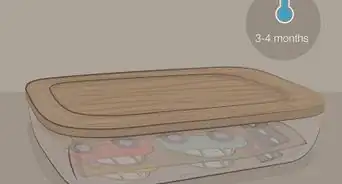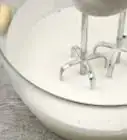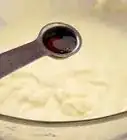This article was co-authored by wikiHow staff writer, Eric McClure. Eric McClure is an editing fellow at wikiHow where he has been editing, researching, and creating content since 2019. A former educator and poet, his work has appeared in Carcinogenic Poetry, Shot Glass Journal, Prairie Margins, and The Rusty Nail. His digital chapbook, The Internet, was also published in TL;DR Magazine. He was the winner of the Paul Carroll award for outstanding achievement in creative writing in 2014, and he was a featured reader at the Poetry Foundation’s Open Door Reading Series in 2015. Eric holds a BA in English from the University of Illinois at Chicago, and an MEd in secondary education from DePaul University.
The wikiHow Video Team also followed the article's instructions and verified that they work.
This article has been viewed 848,694 times.
Learn more...
A piping bag, also known as a pastry bag, is a cone-shaped bag that you fill with icing, frosting, or sauce. You apply pressure to the bag to dispense frosting, icing, or sauce in a specific pattern to make your dish beautiful and tasty. You can make a piping bag by filling a resealable plastic bag and cutting the corner off. If you don't have a plastic bag, you can cut a triangle out of parchment paper and fold it into a cone. If you want to store any left-overs, use a plastic bag since it can easily be packed away. If you have a lot of different icings that you need to use, opt for parchment paper since it's cheap and disposable.
Steps
Using a Resealable Plastic Bag
-
1Get a resealable plastic bag and a pair of scissors. Resealable plastic bags make excellent piping bags because the frosting or sauce won't come out from anywhere but the point that you want it to. Select a plastic bag based on the amount of frosting or sauce that you need to apply to the top of your dish.[1]
- Most packages list the interior volume of the plastic bag. This can make it easy to determine whether a bag is big enough for the recipe.
- A thicker resealable bag, like a freezer bag, is a good choice if you have a thicker frosting that will require a lot pressure to be applied to the bag.
- You can use a non-sealable plastic bag if that's all you have available, but you'll need to twist it at the top once you fill it to close it. These bags also tend to explode when you squeeze them, so they're not great for thicker frostings.
-
2Open your plastic bag and add your icing or sauce with a spoon. Set your bag and other materials out on a cutting board or flat work surface. Open the resealable plastic bag and start scooping your sauce or frosting into the bag.[2]
- One of the advantages of using a plastic bag is that the sauce or icing won't leak out of the bottom while you're adding it.
- You can make a nozzle for your bag by cutting out a flexible strip of matboard or aluminum and wrapping it into a cone before cutting the points out with scissors. Insert the nozzle from the inside before filling your bag if you want one. The pattern that comes out may not be perfect though.[3]
Advertisement -
3Seal the bag at the top to close it. Once you've added your frosting or sauce, seal your bag by running your fingers on the opposite sides of the seal and pressing it together. If you have a plastic bag with a zipper, all you need to do is slide it to the other end of the bag. Push the frosting, icing, or sauce down towards the corner that you're going to cut.[4]
- You can push the air out before sealing it if you want. It'll make it easier to dispense the icing or sauce but it will also come out quicker.
-
4Use scissors to snip a corner of the bag off. Open your scissors and place the blades around the corner of the bag. Line your scissors up so that there is 0.5–2 inches (1.3–5.1 cm) of plastic sticking out past the line that you're going to cut. Close the scissor blades to snip a section of the bag off and make the spout for your piping bag.[5]
- The size of the cut that you make will determine the amount of sauce or frosting that dispenses as you squeeze your bag. The bigger you make the hole when you cut the bag, the more icing or sauce that will come out.
- Lift your bag up with the opening pointing upwards so that your sauce or frosting doesn't spill out.
-
5Hold the bag over your dish and squeeze the bag to use it. Put your nondominant hand around the top of the bag to control the pressure in the bag and move it. Place your dominant hand lightly around the bottom of the bag to control where the icing or sauce comes out. Keep the opening of your piping bag 1–2 inches (2.5–5.1 cm) from the surface of the dish to apply your sauce or frosting.[6]
- If you want to stop dispersing the sauce or frosting, all you need to do is stop squeezing the bag and tilt the opening of the bag upwards.
Tip: If you want to store excess frosting or sauce, put your makeshift piping bag inside a second plastic bag and seal it. Store it in the refrigerator.
Folding Parchment Paper to Make a Cone
-
1Cut a large triangle out of a sheet of parchment paper. Pull out a sheet of parchment paper and cut an isosceles triangle out. The size of your sheet will determine the size of your bag. A triangle with a base of 12 inches (30 cm) is a good general size for applying sauce or frosting.[7]
- You can buy parchment paper from a pharmacy, grocery store, general goods store, or some corner stores.
- The advantage of using parchment paper is that it's extremely cheap and easy to cut. It also comes in rolls, so you can pull out any length to adjust the size of the bag.
-
2Fold 1 corner over the middle of the opposite side. Hold 1 side in front of you with your nondominant hand. Grab the opposite point in your dominant hand and fold your dominant hand over the side that you're holding. Angle it slightly to any side to make one of the openings smaller than the other. Pinch the junction where your side and point meet your nondominant hand.[8]
-
3Continue wrapping the corner around the side until the sheet forms a cone. Keep the side and point pinched lightly together and continue pulling the point around the parchment paper at an angle. Continue pulling it until the narrow opening at the bottom is 0.5–2 inches (1.3–5.1 cm) wide.[9]
- The size of the opening will determine how much sauce or frosting comes out of the bag when you're using it.
-
4Staple the junction where the corner folds over your sheet if you want. You can use the bag without stapling it by simply holding the junction with your nondominant hand as you're using it. If you want to ensure that the paper stays folded though, use a stapler to put a few staples over the area where it overlaps so that it doesn't unfold.[10]
- You can make multiple piping bags ahead of time if you need to use multiple bags while you're baking or cooking.
Tip: If you think that you’ll need to refill the bag at any point, staple it. It will be hard to keep the bag in place and add more sauce or icing at the same time.
-
5Fill the bag with icing, sauce, or frosting by scooping it in with a spoon. Hold the bag on its side and start scooping sauce or icing into the middle of the bag. If the material that you're adding is particularly thin, pinch the opening at the bottom of your cone to keep it closed as you add your icing or sauce.[11]
- You can't really add a nozzle to the tip of your paper pastry bag. It's kind of unwieldy as it is, and the seal won't be airtight around the nozzle.
-
6Fold the top of your bag over to close it. Once you've added a decent amount of icing or sauce, fold the opening at the top over itself to close it. Fold it multiple times to ensure that nothing spills out. Lift the bag and squeeze it to apply your icing or sauce.[12]
- Discard your bag after you've used it. You can't really store it for a long period of time without anything leaking out.
Our Most Loved Articles & Quizzes
Community Q&A
-
QuestionCan I use normal sandwich bags that don't seal?
 Community AnswerYes, all the seal really does is protect your hands from a mess.
Community AnswerYes, all the seal really does is protect your hands from a mess. -
QuestionIf I use the paper piping bag, can I use a nozzle as well?
 Community AnswerYes, you should be able to, just put the desired tip in before you add any icing to the bag. Make sure that the tip is secured in the bag as well.
Community AnswerYes, you should be able to, just put the desired tip in before you add any icing to the bag. Make sure that the tip is secured in the bag as well. -
QuestionHow can I get the frosting to go to the corner without making a big mess when I make a piping bag?
 Community AnswerSlowly squeeze the top if you are using baking paper. And, if using a plastic bag, just close and squeeze gently. Practice on paper or a plate before using it on the actual cake, until you feel comfortable with the piping motion.
Community AnswerSlowly squeeze the top if you are using baking paper. And, if using a plastic bag, just close and squeeze gently. Practice on paper or a plate before using it on the actual cake, until you feel comfortable with the piping motion.
Things You’ll Need
Using a Resealable Plastic Bag
- Resealable plastic bag
- Spoon
- Scissors
Folding Parchment Paper to Make a Cone
- Parchment paper
- Scissors
- Stapler (optional)
- Staples (optional)
- Spoon
References
- ↑ https://www.recipetips.com/kitchen-tips/t--1612/how-to-use-a-pastry-bag.asp
- ↑ https://www.recipetips.com/kitchen-tips/t--1612/how-to-use-a-pastry-bag.asp
- ↑ https://youtu.be/d4_Emi9Carw?t=135
- ↑ https://www.recipetips.com/kitchen-tips/t--1612/how-to-use-a-pastry-bag.asp
- ↑ https://www.recipetips.com/kitchen-tips/t--1612/how-to-use-a-pastry-bag.asp
- ↑ https://www.recipetips.com/kitchen-tips/t--1612/how-to-use-a-pastry-bag.asp
- ↑ https://www.bbcgoodfood.com/videos/techniques/how-make-piping-bag
- ↑ https://www.irishfoodguide.ie/2011/04/making-piping-bag-with-greaseproof.html
- ↑ https://www.irishfoodguide.ie/2011/04/making-piping-bag-with-greaseproof.html
About This Article
If you want to make a piping bag, start by finding a plastic resealable bag that can hold the amount of icing you want to use. Next, scoop your frosting into the bag and push the air out before sealing the bag tightly. Once the bag is sealed, squeeze all of the icing down into 1 corner of the bag and use scissors to snip off the corner of the plastic bag. If you want your bag to produce a thicker flow of icing, you can cut a little more of the corner off the bag. When you're ready to pipe the icing, hold the bag over the cake or cookie and gently squeeze the bag to get the icing flowing. To find out how to make a paper piping bag, keep reading!
